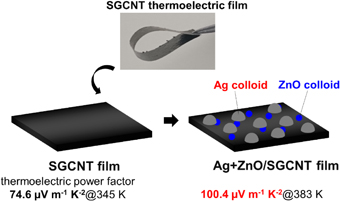88 巻, 5 号
選択された号の論文の29件中1~29を表示しています
- |<
- <
- 1
- >
- >|
The 64th special issue “Frontiers of Carbon Materials”
Vision
-
原稿種別: The 64th special issue “Frontiers of Carbon Materials”
2020 年88 巻5 号 p. 343
発行日: 2020/09/05
公開日: 2020/09/05
PDF形式でダウンロード (230K)
Review
-
原稿種別: The 64th special issue “Frontiers of Carbon Materials”
2020 年88 巻5 号 p. 344-346
発行日: 2020/09/05
公開日: 2020/09/05
[早期公開] 公開日: 2020/07/17PDF形式でダウンロード (229K)
Communications
-
原稿種別: The 64th special issue “Frontiers of Carbon Materials”
2020 年88 巻5 号 p. 347-349
発行日: 2020/09/05
公開日: 2020/09/05
[早期公開] 公開日: 2020/06/23PDF形式でダウンロード (529K) -
原稿種別: The 64th special issue “Frontiers of Carbon Materials”
2020 年88 巻5 号 p. 350-352
発行日: 2020/09/05
公開日: 2020/09/05
[早期公開] 公開日: 2020/06/23PDF形式でダウンロード (694K) -
原稿種別: The 64th special issue “Frontiers of Carbon Materials”
2020 年88 巻5 号 p. 353-355
発行日: 2020/09/05
公開日: 2020/09/05
[早期公開] 公開日: 2020/07/03PDF形式でダウンロード (1315K) -
原稿種別: The 64th special issue “Frontiers of Carbon Materials”
2020 年88 巻5 号 p. 356-358
発行日: 2020/09/05
公開日: 2020/09/05
[早期公開] 公開日: 2020/07/03PDF形式でダウンロード (1352K)
Articles
-
原稿種別: The 64th special issue “Frontiers of Carbon Materials”
2020 年88 巻5 号 p. 359-364
発行日: 2020/09/05
公開日: 2020/09/05
[早期公開] 公開日: 2020/06/23PDF形式でダウンロード (3291K) -
原稿種別: The 64th special issue “Frontiers of Carbon Materials”
2020 年88 巻5 号 p. 365-368
発行日: 2020/09/05
公開日: 2020/09/05
[早期公開] 公開日: 2020/06/23PDF形式でダウンロード (698K) -
原稿種別: The 64th special issue “Frontiers of Carbon Materials”
2020 年88 巻5 号 p. 369-373
発行日: 2020/09/05
公開日: 2020/09/05
[早期公開] 公開日: 2020/06/23PDF形式でダウンロード (2356K) -
原稿種別: The 64th special issue “Frontiers of Carbon Materials”
2020 年88 巻5 号 p. 374-379
発行日: 2020/09/05
公開日: 2020/09/05
[早期公開] 公開日: 2020/07/03PDF形式でダウンロード (1997K) -
原稿種別: The 64th special issue “Frontiers of Carbon Materials”
2020 年88 巻5 号 p. 380-386
発行日: 2020/09/05
公開日: 2020/09/05
[早期公開] 公開日: 2020/07/31PDF形式でダウンロード (4594K) -
原稿種別: The 64th special issue “Frontiers of Carbon Materials”
2020 年88 巻5 号 p. 387-391
発行日: 2020/09/05
公開日: 2020/09/05
[早期公開] 公開日: 2020/07/17PDF形式でダウンロード (1432K) -
原稿種別: The 64th special issue “Frontiers of Carbon Materials”
2020 年88 巻5 号 p. 392-396
発行日: 2020/09/05
公開日: 2020/09/05
[早期公開] 公開日: 2020/07/31PDF形式でダウンロード (2650K) -
原稿種別: The 64th special issue “Frontiers of Carbon Materials”
2020 年88 巻5 号 p. 397-406
発行日: 2020/09/05
公開日: 2020/09/05
[早期公開] 公開日: 2020/07/31PDF形式でダウンロード (4557K) -
原稿種別: The 64th special issue “Frontiers of Carbon Materials”
2020 年88 巻5 号 p. 407-412
発行日: 2020/09/05
公開日: 2020/09/05
[早期公開] 公開日: 2020/08/07PDF形式でダウンロード (1674K) -
原稿種別: The 64th special issue “Frontiers of Carbon Materials”
2020 年88 巻5 号 p. 413-417
発行日: 2020/09/05
公開日: 2020/09/05
[早期公開] 公開日: 2020/08/07PDF形式でダウンロード (2626K) -
原稿種別: The 64th special issue “Frontiers of Carbon Materials”
2020 年88 巻5 号 p. 418-422
発行日: 2020/09/05
公開日: 2020/09/05
[早期公開] 公開日: 2020/08/12PDF形式でダウンロード (3003K)
Technological Reports
-
原稿種別: The 64th special issue “Frontiers of Carbon Materials”
2020 年88 巻5 号 p. 423-428
発行日: 2020/09/05
公開日: 2020/09/05
[早期公開] 公開日: 2020/07/03PDF形式でダウンロード (5656K) -
原稿種別: The 64th special issue “Frontiers of Carbon Materials”
2020 年88 巻5 号 p. 429-433
発行日: 2020/09/05
公開日: 2020/09/05
[早期公開] 公開日: 2020/07/31PDF形式でダウンロード (2770K)
Notes
-
原稿種別: The 64th special issue “Frontiers of Carbon Materials”
2020 年88 巻5 号 p. 434-436
発行日: 2020/09/05
公開日: 2020/09/05
[早期公開] 公開日: 2020/07/03PDF形式でダウンロード (1313K) -
原稿種別: The 64th special issue “Frontiers of Carbon Materials”
2020 年88 巻5 号 p. 437-440
発行日: 2020/09/05
公開日: 2020/09/05
[早期公開] 公開日: 2020/06/26PDF形式でダウンロード (901K) -
原稿種別: The 64th special issue “Frontiers of Carbon Materials”
2020 年88 巻5 号 p. 441-443
発行日: 2020/09/05
公開日: 2020/09/05
[早期公開] 公開日: 2020/07/03PDF形式でダウンロード (700K)
Regular papers
Communication
-
2020 年88 巻5 号 p. 444-446
発行日: 2020/09/05
公開日: 2020/09/05
[早期公開] 公開日: 2020/07/31PDF形式でダウンロード (663K)
Articles
-
2020 年88 巻5 号 p. 447-450
発行日: 2020/09/05
公開日: 2020/09/05
[早期公開] 公開日: 2020/07/10PDF形式でダウンロード (1785K) -
2020 年88 巻5 号 p. 451-456
発行日: 2020/09/05
公開日: 2020/09/05
[早期公開] 公開日: 2020/08/18PDF形式でダウンロード (1037K) -
2020 年88 巻5 号 p. 457-462
発行日: 2020/09/05
公開日: 2020/09/05
[早期公開] 公開日: 2020/07/31PDF形式でダウンロード (3486K) -
2020 年88 巻5 号 p. 463-467
発行日: 2020/09/05
公開日: 2020/09/05
[早期公開] 公開日: 2020/08/12PDF形式でダウンロード (3470K) -
2020 年88 巻5 号 p. 468-474
発行日: 2020/09/05
公開日: 2020/09/05
[早期公開] 公開日: 2020/08/07PDF形式でダウンロード (4511K)
Correction
-
2020 年88 巻5 号 p. 475
発行日: 2020/09/05
公開日: 2020/09/05
[早期公開] 公開日: 2020/08/07PDF形式でダウンロード (168K)
- |<
- <
- 1
- >
- >|




